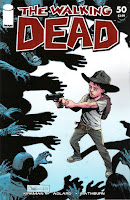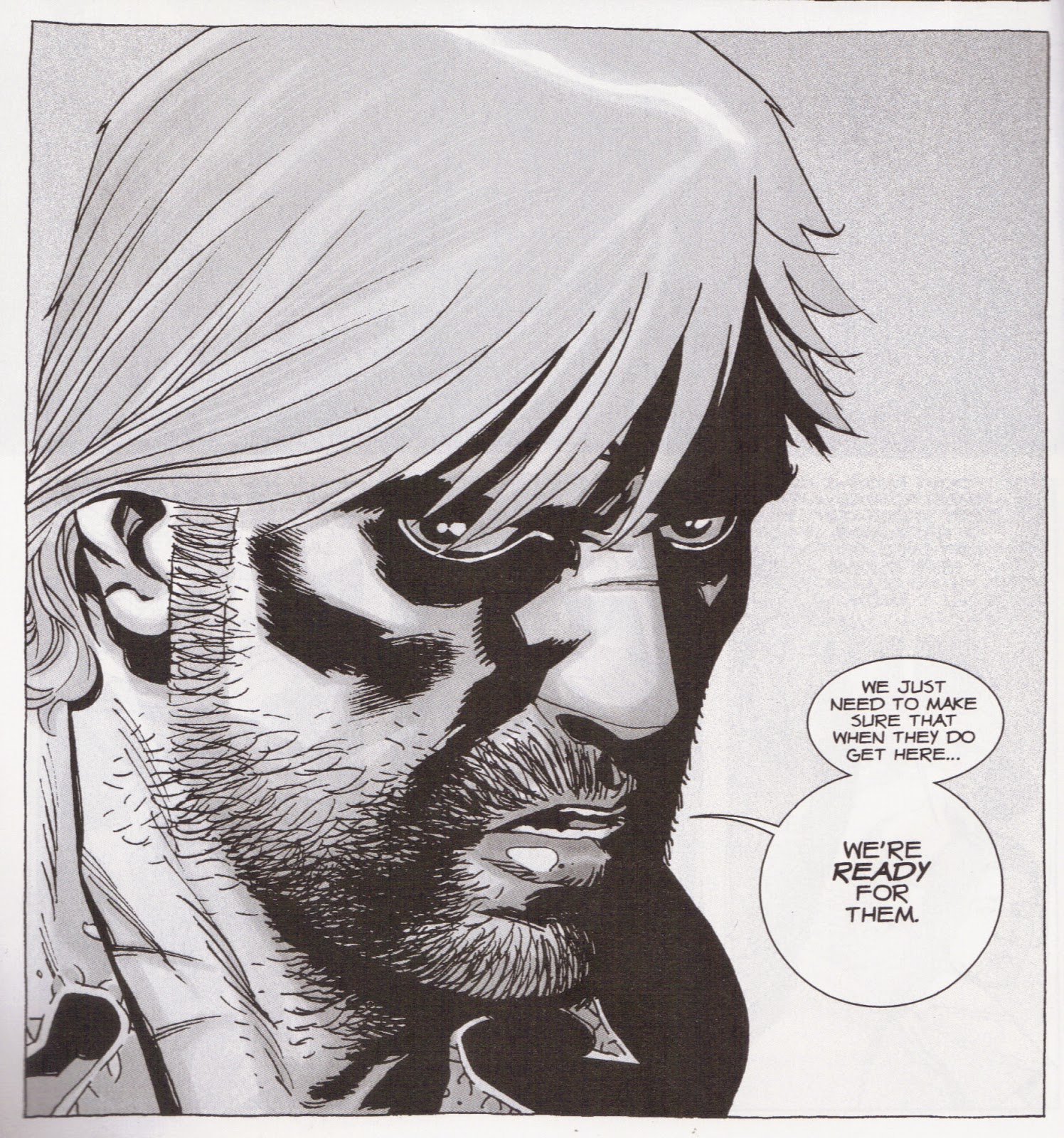 |
| First issue covers: Fantastic Four: Foes (2005) by Jim Cheung and Before the Fantastic 4: The Storms (2000) by Charlie Adlard. |
 |
| Cover to The Walking Dead #50 by artist Charlie Adlard. |
While Kirkman has had success on Marvel properties such as (shocker!) Marvel Zombies (2005), the real back issue find here for me was Adlard's early work on an unusual background building mini-series featuring two key members of Marvel's First Family. Other than the recent publication of his earlier online series Astronauts in Trouble (hailed in recent Image solicits as "The series that brought... artist Charlie Adlard to the attention of Robert Kirkman"), I haven't seen any other work by him, that is, until now. Both Fantastic Four: Foes, written by Kirkman, and Adlard's pencils on Before the Fantastic 4: The Storms reveal two independent creative minds that would one day cumulatively birth The Walking Dead cultural phenomenon.
Fantastic Four: Foes was released as a six issue limited series in 2005 written by Robert Kirkman with art by Cliff Rathburn. Though I have not read any of Kirkman's other superhero books (Ultimate X-Men and his creator-owned Invincible, for example), this one plays into the strengths demonstrated in both The Walking Dead comic and television show: nuanced character development, with an emphasis on smaller interpersonal character interactions. This approach works well as this miniseries seeks to show us the Fantastic Four as family; the entire traditional supporting cast is along for the ride including Alicia Masters and the Richards children. The focus of the narrative is on how two of the family's foes (get it?) team-up to use the combined powers of nearly their entire rogues gallery to finally defeat them. In telling the story, Kirkman tries to get at what motivates individuals, in this case super powered crazy individuals, to repeatedly attempt to do that thing which they have demonstrated little ability to succeed at: defeat Marvel's First Family.
 |
| Interior art by Cliff Rathburn from FF: Foes (2005), issue #5. |
Cliff Rathburn's artwork is also fairly clean consisting of sharp lining and bright colors giving the book a look similar to an animation cell (perhaps this pairing was intentional as by this time Kirkman and Adlard had been working together and a clearly positive stylistic synergy had been developed). In Rathburn's hands, even the Thing's crusty rock-like hide, though minimally shaded for depth and texture, is smoothed and softened for a look very much like that of the old cartoon from the 1980s. Some awkward facial expressions aside, Rathburn's art does a good job communicating the close interpersonal relationships of the characters, even during series of panels with little to no dialogue.
After reading the limited series for the first time since its publication, it surprised me how many plot and character points have since become part of of Fantastic Four cannon. As a means of holding the captured villains, Reed builds a new Vault (prison) in the Negative Zone, a vision that would eventually be seen in the mainstream Marvel comic book universe during the 2006-2007 Civil War event. (In that continuity, the prison from Foes is not referenced as the Civil War prison is code named "Project 42" because it was the 42nd project they had developed after the Stamford tragedy.) Also, this series reintroduces the possibility of a bearded Reed Richards leading the team. Though used briefly following Reed's return form being lost in the past, the current visual presentation of Mr. Fantastic with full beard in Secret Wars is a design which is now cannon.
 |
| Just like old times: In issue #1 Johnny is back to fixing cars! |
At its core, The Storms is about showing the groundwork of these two key characters that could logically result in the building of the superhero team. This set-up, of course, leads the brother, sister and friends into conflict with all sorts of creatures of the night. In addition to the monsters they battle, other recognizable plot devices turn-up throughout the proceedings. The first issue alone includes the classic Scooby-Do investigative strategy of having a character, in this case Johnny, hide in a suit of armor as others offer helpful exposition and clues. As corny as this may sound, and as familiar as the tropes being intentionally applied may be, The Storms is a whole lot of fun.
Perhaps somewhat prophetically, the Storms' adventures give Charlie Adlard perhaps his earliest opportunity to publish artwork chock full of ghouls, monsters, and... wait for it... zombies! As entertainingly structured as Kavanaugh's narrative is, it is Adlard's artwork which grounds The Storms. The creatures that pursue and battle our heroes fit neatly into the real world visuals established by the artist in the first issue. Interestingly, the mini-series doesn't feel like a "superhero comic book" until one makes a brief guest appearance in the final issue.
The elements of Adlard's work that make The Walking Dead such an engaging read are visible in this earlier work--with the notable addition of a color palette beyond blacks, white and gray tones. Dynamic action and willingness to break from panel conventions in the interest of building energy propel the action forward. In fact, while much of the action in The Walking Dead is responsive in nature (the characters are acting out of necessity to survive certain circumstances), it was nice to see this dynamic flipped as the Storms take the fight to the bad guys. This slight shift in motivation is interesting to note.
 |
| Left, original panels from The Storms #3, right: same panels recolored in grey-scale. |
Given its growing place in popular culture, I am confident that someday a graduate student somewhere will write an amazing analysis of Robert Kirkman and Charlie Adlard's Walking Dead work in contrast to their earlier efforts. With little doubt, this analysis of those creative seeds will be of interest to both fans of the product as well as fans of good literature (which Walking Dead most certainly is). Until then, I will continue to periodically comb through my longboxes, hoping to inadvertently stumble across these sorts of issues. Not only does it create the chance to re-read such excellent mini-series as Fantastic Four: Foes and Before the Fantastic 4: The Storms in light of more recent comics, but, as is the case with these two minis, it's fun top revisit a time when superhero comic books had a stronger sense of FUN.
 |
| Eventually a precursor to Ghost Rider makes an appearance in The Storms #3. |












